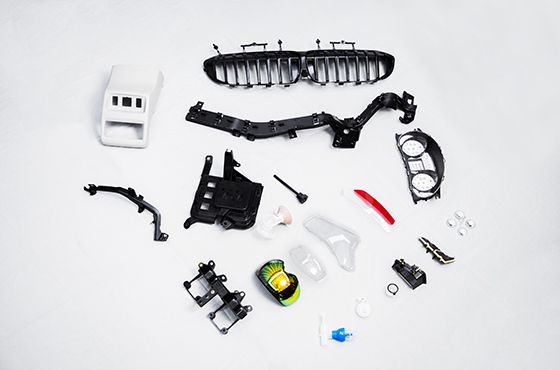- Heat balance control of injection mold The heat transfer between the injection molding machine and the mold is the key to producing injection molded parts. Inside the mold, the heat brought by the plastic (e.g., thermoplastic) is transferred to the material and the steel of the mold through heat radiation and to the heat-conducting fluid through convection.
In addition, heat is transferred to the atmosphere and the mold frame through thermal radiation. The heat absorbed by the heat-conducting fluid is carried away by the mold heater. The heat balance of the mold can be described as P=Pm-Ps, where P is the heat removed by the mold heater; Pm is the heat introduced by the plastic, and Ps is the heat emitted by the mold to the atmosphere.
- Preliminary conditions for effective control of mold temperature control system consist of three parts: mold, mold temperature machine, and heat-conducting fluid. To ensure that heat can be added to the mold or removed, each part of the system must meet the following conditions: firstly, inside the mold, the surface area of the cooling channels must be large enough, and the diameter of the flow channels must match the capacity of the pump (pump pressure)
The temperature distribution in the cavity has a significant influence on the part deformation and intrinsic pressure. Correctly set cooling channels can reduce the intrinsic pressure, thus improving the quality of the injection molded parts. It can also shorten the cycle time and reduce product costs.
Injection molding suppliers remind that secondly, the molding machine must be able to make the temperature of the heat-conducting fluid constant in the range of 1℃-3℃, depending on the quality requirements of the injection molded parts. The third is that the heat-conducting fluid must have good heat transfer capability, and most importantly, it must be able to import or export a large amount of heat quickly. From the perspective of thermodynamics, water is better than oil.
- Working principle of the mold temperature machine consists of a water tank, heating and cooling system, power transmission system, liquid level control system and temperature sensor, injection port, and other devices. Typically, the pump in the power transmission system makes the hot fluid reach the mold from the tank equipped with a built-in heater and cooler and then return to the tank from the mold; the temperature sensor measures the temperature of the hot fluid and transmits the data to the controller in the control section; the controller regulates the temperature of the hot fluid, thus indirectly regulating the temperature of the mold.
Suppose the temperature of the mold exceeds the set value of the controller during the production of the mold temperature machine. In that case, the controller will open the solenoid valve to connect the inlet pipe until the temperature of the hot fluid, i.e., the mold temperature, returns to the set value. If the temperature of the mold is lower than the set value, the controller will turn on the heater.
- The types of mold temperature controllers are divided according to the heat-conducting fluid (water or heat-conducting oil) used. The maximum outlet temperature is usually 95℃ with a water-carrying type mold heater. With oil transport type mold temperature machine for the working temperature ≥ 150 ℃. Usually, the mold temperature machine with open water tank heating is suitable for use with water or oil temperature machine, the maximum outlet temperature of 90 ℃ to 150 ℃, the main feature of this kind of mold temperature machine is simple design and economical price.
Based on this machine and derived from a high-temperature water temperature machine, its allowable export temperature of 160 ℃ or higher. Because the temperature is higher than 90 ℃, the heat transfer of water to the same temperature as the oil is much better, so this machine has outstanding high-temperature workability.
Custom plastic mold manufacturers introduce, in addition to this, there is a forced-flow mold heater, which is designed to work at 150°C or higher for safety reasons, using heat transfer oil. To prevent the oil in the mold heater from overheating, the machine uses a forced-flow pumping system, and the heater consists of a certain number of stacked tubes with heating elements equipped with fins to guide the flow.
- The temperature inside the control mold is not uniform at all points, which is also related to the time point in the injection cycle. After the injection, the temperature of the mold cavity rises to the highest when the hot melt hits the cold wall of the mold cavity, and when the part is removed, the temperature drops to the lowest. The role of the mold temperature controller is to keep the temperature constant between θ2min and θ2max, i.e., to prevent the temperature difference Δθw from fluctuating up and down during the production process or in between.
The following control methods are applicable to control the temperature of the mold: Controlling the fluid temperature is the most commonly used method, and the control accuracy can meet the requirements of most cases. Using this control method, the temperature shown in the controller and the mold temperature could be more consistent; the temperature of the mold fluctuates considerably, and the thermal factors affecting the mold are not directly measured and compensated for. These factors include changes in the injection cycle, injection speed, melting temperature, and room temperature.
The second is the direct control of the mold temperature. The method is to install temperature sensors inside the mold, which is only used when the mold temperature control accuracy is relatively high. The main features of mold temperature control include the following: the temperature set by the controller is consistent with the mold temperature; the thermal factors affecting the mold can be directly measured and compensated.
Usually, the stability of the mold temperature is better than controlling the fluid temperature. In addition, mold temperature control has better repeatability in production process control. The third is joint control. Joint control combines the above methods to control both fluid and mold temperatures. In joint control, the location of the temperature sensor in the mold is significant. When placing the temperature sensor, the cooling channels’ shape, structure, and location must be considered. In addition, the temperature sensor should be placed where it plays a decisive role in the quality of the injection molded part.

Connecting one or more mold thermostats to the injection molding machine controller in many ways. For operability, reliability, and immunity to interference, it is preferable to use a digital interface such as RS485, where information can be passed between the control unit and the injection molding machine via software. The mold temperature machine can also be controlled automatically.
- The configuration and use of the mold temperature machine should be determined according to the material to be processed, the weight of the mold, the required preheating time, and the productivity kg/h. When using heat transfer oil, the operator must observe such safety regulations as
Do not put the mold temperature machine close to the heat source furnace; joints use a tapered leak-proof and temperature and pressure-resistant hose or rigid pipe; regularly check the temperature control circuit mold temperature machine, joints, and molds for leaks and normal function; regularly replace the heat transfer oil; should use synthetic oil, good thermal stability and low coking tendency.
Choosing the appropriate heat transfer fluid is critical in mold temperature machine. Using water as a heat transfer fluid is economical, clean, and easy to use. Once the temperature control circuit, such as the hose coupling, leaks, the water flowing out can be discharged directly to the sewer. However, water as a heat transfer fluid also has disadvantages: the boiling point of water is low; depending on the composition of the water, it may corrode and scale, causing increased pressure loss and heat exchange efficiency between the mold and the fluid is reduced, etc… When using water as a heat transfer fluid, the following precautions should be considered: pre-treat the temperature control circuit with an anti-corrosion agent; use a filter before the water inlet; periodically clean the water heater and the mold with a descaling agent.
There is no disadvantage to water when using heat transfer oil. The boiling point of the oil is high, it can be used for temperatures higher than 300 ℃ or even higher, but the heat transfer coefficient of heat transfer oil is only 1/3 of water, so the oil temperature machine in injection molding is not as widely used as the water temperature machine.
